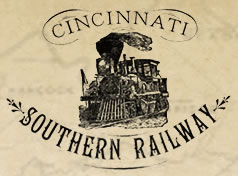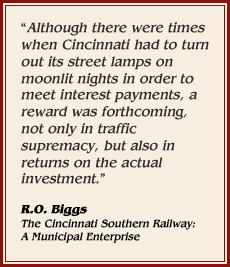The idea of rail transportation was starting to take hold as early as 1835 when Cincinnati held its first public meeting to discuss a line between the Queen City and the cities of the South. It would be the following year, in July 1836, that the city would send a delegation to the Great Southwestern Railroad Convention conceived by John C. Calhoun. A Cincinnati, Louisville, Charleston line shows promise, but the financial crash of 1837 derails the project.
Ohio Constitution prohibits counties, cities and towns from becoming owners in any joint stock company, thereby hampering Cincinnati's ability to construct its railway.
Photo courtesy of the Ohio Division of Travel
and Tourism
General Burnside offers his plan to establish a military railroad to the South, with President Lincoln recommending its construction to Congress in December 1861. Cincinnati was considered for the railway connection and surveys were made, but other war events overshadowed the project and it too was abandoned.
E.A. Ferguson puts forth his "remarkable proposition" that the City of Cincinnati itself should build and own a southern railway. His idea was endorsed in the November 25, 1868 edition of the Cincinnati Daily Enquirer and the City of Cincinnati spent $578.90 lobbying for the measure in Columbus.
Ferguson's proposition becomes a bill that is passed by the Ohio Legislature and is then brought to the citizens for a vote. On June 26, the City of Cincinnati votes for $10 million in bonds to build the railway with 15,435 votes for and just 1,500 against the measure. Historian accounts reported that "the day was made a holiday. Nine bands of music paraded the street. The fire bells rang at six in the morning, at noon, at three in the afternoon. Various wards organized. A full vote was urged."
Three years after construction started on the railroad, the first $10 million in bonds was used and the Trustees were forced to ask the City of Cincinnati for an additional six million dollars to complete the road. On March 14, the city approved the additional funds by a vote of 21,433 to 9,323.
Photo by Greg Hume
The railroad opens to passenger traffic on the completed portion from Ludlow to Somerset
on July 23. Three weeks later, on August 13,
the first freight traffic began running on the Cincinnati Southern Railway.
The Trustees again were forced to ask the citizens of Cincinnati for more funds to complete the railroad. However, public opposition to the railroad was starting to swell and the people of Cincinnati were concerned that another two million would not be enough. Though the paper wrote in support of the funding, the Cincinnati Enquirer also mocked the railroad as ìour white elephantî and the measure was defeated by a razor-thin margin of 11,179 to 11,349 on May 3. Three months later, under the strict requirement the railroad completion could not exceed two million dollars, voters ultimately decided to support the railway funding measure 16,244 to 10,424.
On February 21, the first freight train completed the 337 mile journey from Cincinnati to Chattanooga. Two weeks later, on March 8, the first passenger train completed the route. The completion of the railroad was celebrated by a grand banquet at Music Hall on March 18. Trainloads of southern dignitaries were brought to Cincinnati for what was described as "the largest banquet ever spread in the United States, up to that date."
The first attempt to purchase the Cincinnati Southern Railway was made by the Southwestern Construction Company. The attempt was brought to the citizens of Cincinnati and failed by 338 votes, 15,493 to 15,931.
The Cincinnati Southern Railway undergoes major reconstruction to modernize the railroad.
The City of Cincinnati renegotiates the terms of the lease for a more favorable annual income. In accordance with a recommendation in the Smale Commission report, the City Council endorses a policy to dedicate funds generated by the Southern Railway to infrastructure projects.
Photo courtesy of Terry Cantrell
Between 1820 and 1860, Cincinnati’s population exploded by more than 150,000, bringing it to 161,044. As the fourth largest city in the country and the largest city west of the Alleghenies, Cincinnati had a strategic location and thriving commercial business. But with the advent of rail transportation, the importance of Cincinnati’s river location was diminished and it became obvious the Queen City would have to adapt.
As rail developed rapidly, Cincinnati recognized that lines extended primarily from East to Northwest, excluding a connection from the Northwest to the South, and became determined to meet that need. The Cincinnati Southern Railway was born of a need to link the natural resources of the South to the industrializing Midwest. While the track to success was hardly a direct route, the CSR turned into a profitable enterprise unique in American history as the only long-distance railroad owned by a municipality.
View the complete timeline for even more information












